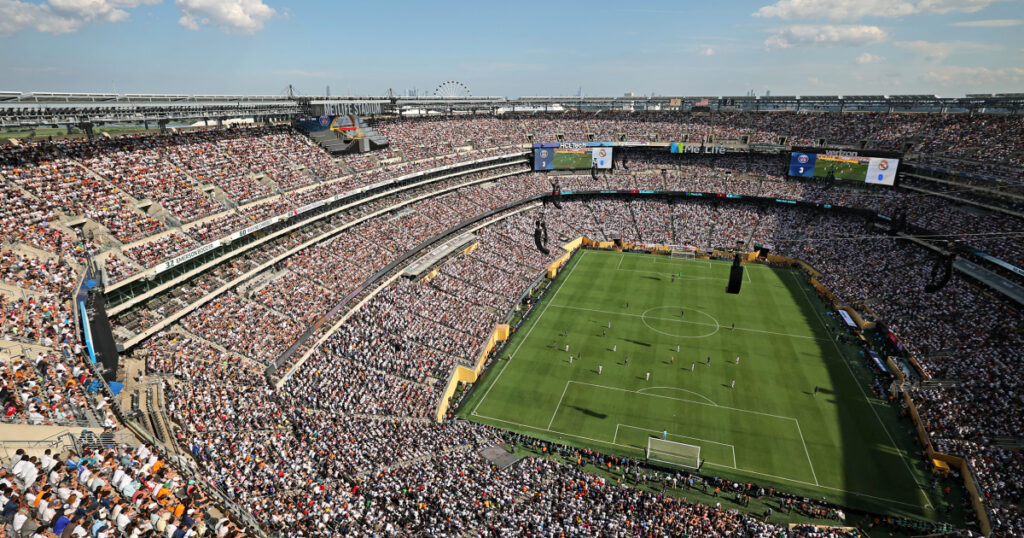
The Club World Cup final on Sunday at MetLife Stadium in New Jersey features two of the world’s most prominent soccer teams, Chelsea and Paris Saint-Germain. This tournament serves as a crucial test of the United States’ readiness to host the upcoming FIFA World Cup in June and July 2026. As the first World Cup in North America since 1994, the event carries significant economic and logistical implications, with projections from Pitch Marketing Group estimating revenues for FIFA alone will exceed $10 billion.
The tournament marks a pivotal moment for soccer in the U.S., coinciding with the expansion of the World Cup from 32 to 48 teams for the first time in its history. The Club World Cup, which has been revamped to include 32 teams and a staggering $1 billion in total prize money, sets the stage for this transformative year in American soccer. Sunday’s winner could take home up to $125 million, underscoring the stakes involved.
FIFA President Gianni Infantino emphasized the importance of hosting the Club World Cup in the U.S. at a recent event in New York. “Our objective is to make soccer the No. 1 sport in America,” he stated. The enthusiasm among fans at the semifinals, where Chelsea faced Brazilian club Fluminense, highlighted this vision. Attendees noted the vibrant atmosphere and the significance of hosting such an event in North America.
As the tournament progressed, attendance figures reflected growing interest. The average attendance for group stage matches reached 35,000, with the semifinals attracting nearly full capacity crowds of 70,000 and 77,000 spectators. According to FIFA, over 2.3 million fans from 180 countries have attended matches, a figure that exceeded expectations.
Despite the excitement, challenges emerged regarding the U.S. readiness for the World Cup. Concerns about attendance and the sustainability of broadcast contracts were raised. Adam Crafton, a soccer writer for The Athletic, noted that while FIFA heralded the event as “epic” and “unprecedented,” the reality might be more complex. He expressed uncertainty over some earlier matches, which featured less popular clubs.
FIFA’s Manolo Zubiria, chief tournament officer for the 2026 World Cup, acknowledged the weather as a significant challenge, particularly the heat affecting players and fans. Although FIFA implemented cooling measures, some attendees reported issues related to high temperatures, including health complications for vulnerable individuals.
In addition to logistical concerns, immigration policies under the current U.S. administration raised questions about their potential impact on international fans attending the tournament. Concerns were voiced regarding how Customs and Border Protection would treat attendees. However, FIFA representatives stated they had not observed any immigration enforcement at the matches.
Ticket pricing also sparked discussion, as FIFA’s dynamic pricing strategy led to significant fluctuations. Prices for the semifinal between Chelsea and Fluminense ranged from $473.90 to $13.40. This disparity elicited mixed reactions, with some fans feeling fortunate and others frustrated.
The combined economic impact of the Club World Cup and the 2026 World Cup is forecasted to reach $47 billion, according to FIFA and the World Trade Organization. Interest in soccer continues to surge in the U.S., with viewership of top leagues increasing by 60% since 2018.
For many young fans, like Mohamed Berkouk, who relocated from Algeria, this tournament presents an exciting opportunity to witness high-caliber soccer. “In my country, you don’t have big opportunities like this,” he remarked.
With the Club World Cup and the 2026 FIFA World Cup on the horizon, the landscape of soccer in the U.S. is poised for significant change. As enthusiasm builds, the hope is that these events will help solidify soccer’s place in the American sports culture.







